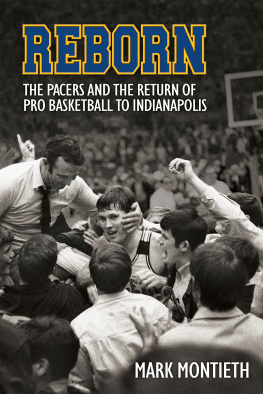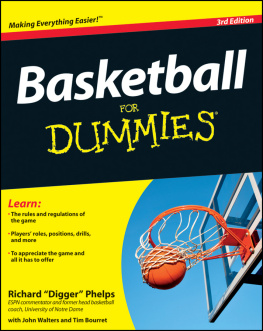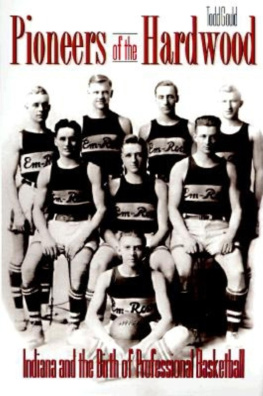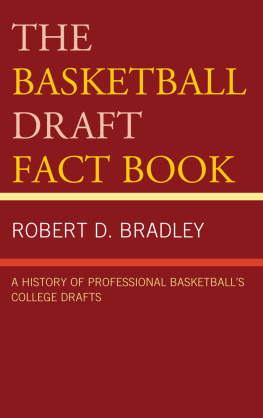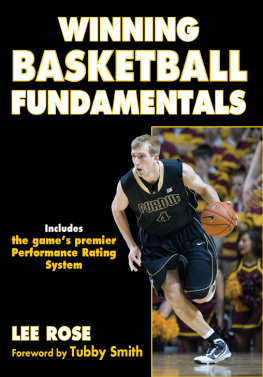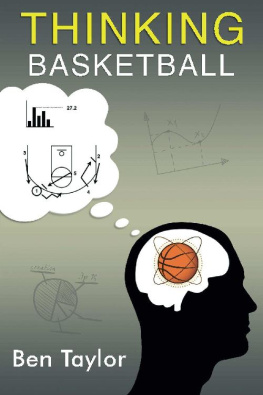Table of Contents
Pagebreaks of the print version

REBORN
THE PACERS AND THE RETURN OF
PRO BASKETBALL TO INDIANAPOLIS

Mark Montieth
_____________________
HALFCOURT PRESS
Indianapolis, IN
Reborn: The Pacers and the Return of Pro Basketball to Indianapolis 2017 Mark Montieth
EAN-ISBN-13: 9780998729800
All rights reserved under International and Pan-American Copyright
Conventions
No part of this book may be reproduced, stored in a database or other retrieval system, or transmitted in any form, by any means, including mechanical, photocopy, recording or otherwise, without the prior written permission of the publisher.
Cover designed by Phil Velikan
The photographs contained herein are from my private collection or were loaned to me for use in this book. No copyrights were knowingly violated by the reproduction of the images within these pages.
Packaged by Wish Publishing
Printed in the United States of America
10 9 8 7 6 5 4 3 2 1
Distributed in the United States by Cardinal Publishers Group.
www.cardinalpub.com
Acknowledgements
This book was decades in the making, an on-and-off-again project fit into the cracks of a career that spanned newspapers, radio and freelance writing. I talked with dozens of people and read a mountain of printed material during my research, especially if everything I read on the internet had been printed out.
My primary sources were from the microfilms of The Indianapolis Star and The Indianapolis News, printed out one at a time for 10 cents a page in the Marion County Public Library. Those eyeball-burning sessions were long, but not particularly grueling for a kid who had grown up in the city and enjoyed re-reading the sports sections of his youth.
Thanks to www.newspapers.com, I also combed through the Pacers coverage in the Kokomo Tribune. One of my great regrets is not meeting with Gene Conard to gather his recollections before he passed away in 2015. Im told he was a pack rat, so he probably would have had reams of wrinkled paper to wade through in search of golden nuggets. I also found details in the Madison Courier, Franklin Daily Journal and Tipton Daily Tribune that appeared nowhere else. The websites inclusion of newspapers in Dallas, Detroit, Cincinnati, Louisville, Chicago, Minneapolis, Oakland, Los Angeles and Pittsburgh also was a major asset, one that added many more hours to my research but provided much more information and better perspective.
Special mention must go to Chuck DeVoe, who not only sat for an interview but passed along his brother Johns files and oversized scrapbooks. They provided a treasure trove of inside information that had never been published.
Bill Halls of the Detroit News also deserves special thanks. He went well beyond the call of journalistic duty about 25 years ago by photocopying his newspapers clip file on Reggie Harding and mailing it to me. He also passed along a classic anecdote on the tragic figure.
So many people were generous with their time and memory in granting me interviews, most of them numerous times. I began working on this book in the early Nineties, but real life kept getting in the way and delaying the project. Had I finished a couple of decades earlier, I would have had access to more people, including crucial figures such as Joe Bannon and Lyn Treece. But, I would not have had as much time to press others for details that never ceased to impress me, or have had access to the newspapers.com website.
I talked with every player on the original Pacers team of the 1967-68 season other than Harding, who died in 1972. What a fascinating conversation one could have had with him in his final months. Ill have to settle for his autograph, obtained at the Indianapolis airport when I was 12 years old. Unfortunately, the notes from my early 90s telephone conversation with Matthew Aitch were stored on a 3-inch floppy disk and didnt withstand the test of time. Even more unfortunately, my conversations with Roger Brown before he passed in 1997 were either informal or geared toward more current events. I never did get the opportunity to grill him on his life or the early seasons of the franchise. I also talked with five members of the second team who hadnt played the previous season.
The following people were of great assistance by agreeing to be interviewed and being so generous with their time. Apologies and thanks to anyone I have mistakenly omitted from this list: Jerry Baker, Lisa Barnes, Rick Barry, John Beasley, Bob Bernath, Bill Bevan, Tom Bolyard, Ron Bonham, Larry Brown, Bob Collins, Carolyn (Brown) Jeffries, Steve Chubin, Louie Dampier, Cece Daniels, Mel Daniels, Oliver Darden, Jim Dawson, Chuck DeVoe, Jane (DeVoe) Nolan, Craig Dill, Terry Dischinger, Dick Ebershoff, Bobby Joe Edmonds, Wayne Fuson, Hilliard Gates, Joe Gregory, Bill Hampton, Jerry Harkness, Jim Holstein, Bob Hooper, Tom Hoover, Larry Humes, Ron Kozlicki, Bob Leonard, Nancy Leonard, Freddie Lewis, Mike Lewis, Clyde Lovellette, Lyle Mannweiler, Bill Marvel, Jon McGlocklin, Bill McGowan, George Mikan, Dick Mittman, Jim Morris, Bob Netolicky, George Peeples, Ron Perry, Jim Rayl, Nancy Rayl, Gene Rhodes, Oscar Robertson, Will Robinson, Dick Russell, James Sommer, Dave Schellhase, Ted Sizemore, Joyce Staverman, Larry Staverman, Keith Stone, Mike Storen, Scott Tarter, Tom Thacker, Dick Tinkham, Gary Todd, Kip Treece, Tom Van Arsdale, Sandra Wheatley, Ted Wheeler, Fred Wiese, and Bill York.
And, not to be forgotten, thanks to my wife, Faith, for keeping the, uh, faith and putting up with all the hours, days, months, and years I spent completing this project especially the late hours when I barely made it to bed before she had to get up to teach school. I couldnt have done it without her support and patience.
As of this moment, the Indianapolis club ceases to function.
It is not going to operate again.
Introduction
Some beginnings require an ending. The Pacers couldnt have been born without one. Or three.
Before they could tip off a game in the American Basketball Association, three other professional basketball teams in Indianapolis had to fade into oblivion or die a painful death. Other teams that paid players had come and gone in the early decades of the 20th century, but three in particular combined to draw a (nearly) continuous line from 1932 to 1953, setting the stage for what was to come in 1967.
Their stories could fill a book of their own, and hopefully will someday, but for now a preface will have to summarize their histories to set the stage for what happened later.
The first professional team in Indianapolis that lasted a meaningful length of the time was the Kautskys. They were owned by Frank Kautsky, who owned a grocery store on South Madison Ave. He was a good guy by all accounts emotional and generous by nature, not particularly knowledgeable about basketball, but committed to the game and the fun of hanging out with his players. They, also by all accounts, liked playing for him.
He got started with an amateur team. Pete Bailey, who had just graduated from Indiana Central College, talked him into sponsoring a group of players who went out and won the state championship. Flushed with enthusiasm for involvement in the growing game, Kautsky recruited Johnny Wooden to commit to playing for him on a professional team. Wooden, who had just graduated from Purdue, ranked as one of the greatest guards in the sports 40-year history. He had been a first-team All-American in all three of his varsity seasons and was his conferences all-time leading scorer. Before that, he had led his high school team, Martinsville, to three consecutive appearances in the final game of the state tournament and one championship.

